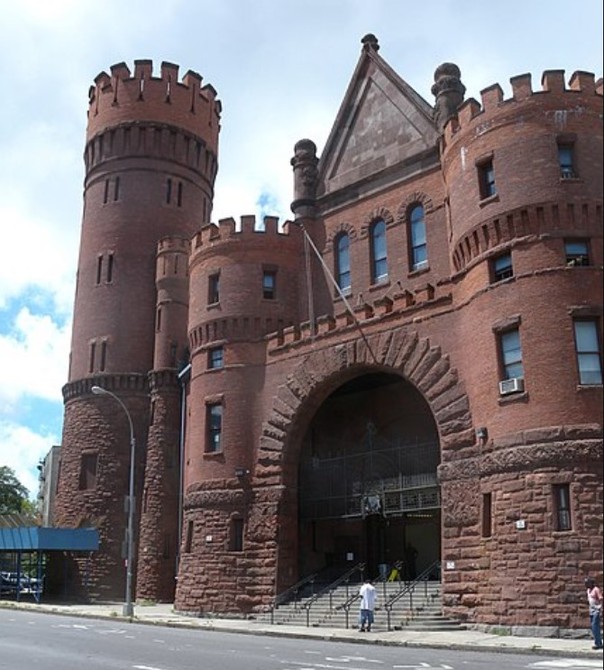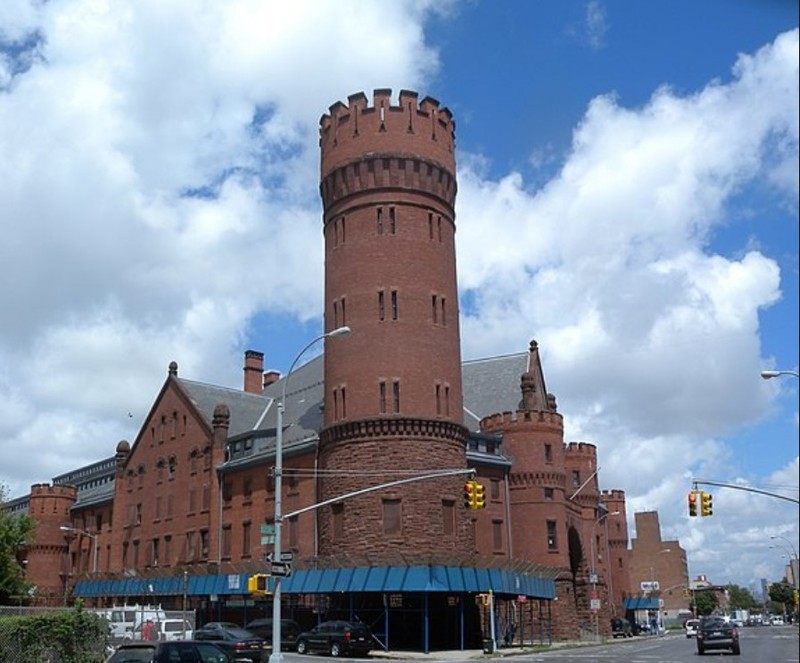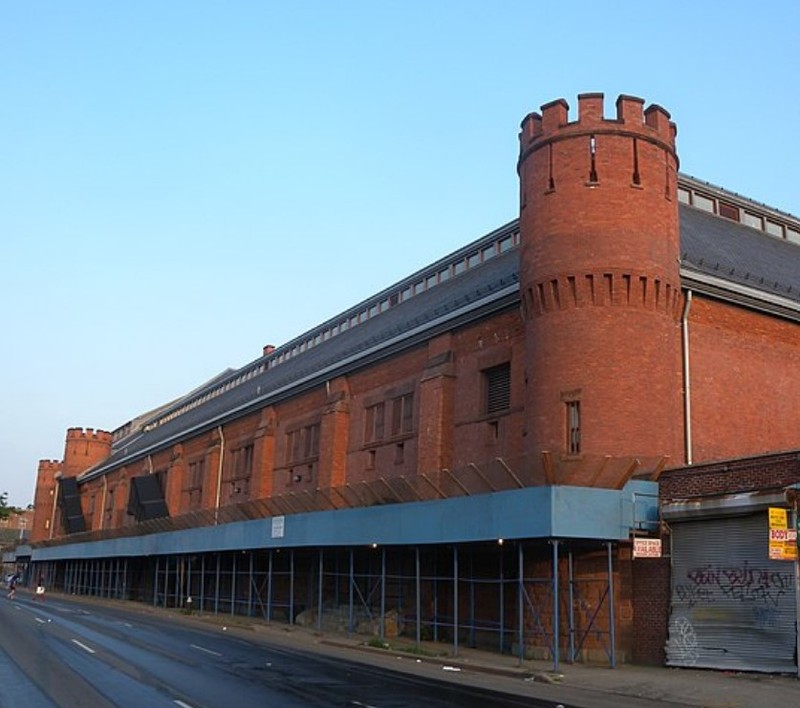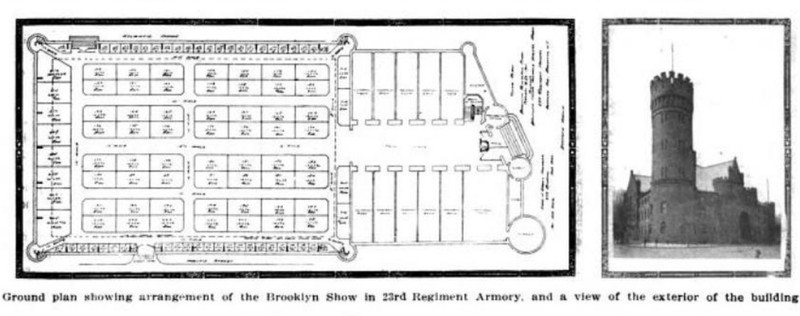Twenty-Third Regiment Armory
Introduction
Text-to-speech Audio
This castle-like structure in the heart of Brooklyn served as an armory for the Twenty-Third Regiment of the New York State Militia and was built from 1891 to 1895. The brick and brownstone armory takes up much of the block between Atlantic and Pacific Avenues and became a New York City landmark in 1977 and was listed in the National Register of Historic Places in 1980. The building has been used as a homeless shelter since the 1980s and has acquired the nickname "Castle Greyskull." The City of New York restored the structure in 2003. Alternate future uses were proposed in 2012, including use as an ice-skating rink, climbing facility, or concert hall.
Images
View of 23rd Regiment Armory's main entrance looking southwest across Bedford Ave. in 2010 (Jim.henderson)

23rd Regiment Armory as seen across Pacific Ave./ Bedford St. intersection in 2010 (Jim.henderson)

Northwest corner of armory's drill shed along Atlantic Ave. in 2010 (Jim.henderson)

Floor plan of Armory for car show plus exterior view of building from 1910 trade journal

Backstory and Context
Text-to-speech Audio
The 23rd Regiment of the New York Guard Reserve, nicknamed "Ours," served briefly in the Civil War in 1863. Their first armory in Brooklyn was built on Clermont St. in the early 1870s but proved to be too small. When the land on Bedford Ave. between Atlantic and Pacific Aves. was purchased for the site of a new armory, it held St. Bartholomew's school, a rowhouse owned by Halstead P. Fowler (one of the architects of the armory), and two farmhouses. Colonel John N. Partridge was the head of the 23rd in the 1890s. Partridge also was President of the Brooklyn City and Newtown Railroad Company. The cornerstone of the new armory on Bedford St. was laid on November 14, 1891. Construction was partly funded by a $300,000 grant from the state; the architectural firm was Fowler & Hough. A fair was held that raised $70,000 to furnish the armory's interior.
The building covers all but the west end of an irregularly shaped block and includes an administration building plus a drill hall. The dark red brick is accented by brownish-red Potsdam stone and terra cotta. The corner towers are circular and up to 136 feet tall; the main entrance is flanked by 70-foot-tall towers with a stone first story. The regimental motto and coat of arms ornament the main entryway arch in terra cotta; hydraulic pumps raised and lowered the metal gate. A large bronze high-relief panel on the outer wall on Bedford St. between the main entrance and Atlantic Ave. was created by sculptor J. Massey Rhind (1868-1936). It depicts life-size World War I soldiers leaving a trench and going into battle. During World War I, New York's 23rd Regiment was part of the U.S. Army's 106th Infantry Regiment. The upper corners are inscribed "1917" and "1919" and the monument is dedicated to the men of the regiment who lost their lives during World War I. The artwork was dedicated on November 11th, 1922.
The armory was designed for military training and for a military club. The Council Room contains a massive fireplace that is 24 feet high. The armory building has been used for large meetings, including the 115th Annual Meeting of the Medical Society of the State of New York, held in May 1921. The large space of the drill hall has held auto shows; the first annual display of the Brooklyn Motor Vehicle Dealers' Association took place there in February 1911 and the armory was the chosen venue again in 1912. An auto trade journal in 1910 touted the armory as immense, with more floor space than Madison Square Garden; the color scheme was set as white and gold. The public was charged 25 cents admission to the first show in 1911, except for two days with special events, where ticket prices doubled. Brooklynites were said to own more cars than any American city's residents in 1910, except for Manhattan residents. Publisher William Randolph Hearst briefly leased the armory building in 1923 after the studio of his Cosmopolitan Productions company was lost in a fire.
Sources
Anonymous. Brooklyn's Show in White and Gold Glory. The Automobile, vol. 23, no. 1, 1013 - 1013. Published December 15th 1910.
Anonymous. Motoring News of National Import. The Automobile Journal, vol. 32, no. 11, 38 - 43. Published January 17th 1912.
Anonymous. "Bedford-Atlantic Armory one of most dangerous shelters in NYC." Brooklyn Daily Eagle (Brooklyn) April 26th 2018.
Diamonstein-Spielvogel, Barbaralee. The Landmarks of New York: An Illustrated Record of the City's Historic Building. Edition 5th. Albany, NY. State University of New York Press, 2011.
Medical Society of the State of New York. Medical Society of the State of New York, 17 West 43rd Street, New York. New York State Journal of Medicine, vol. 21, no. 2, 63 - 66. Published February 1st 1921.
NYC Landmarks Preservation Commission. Designation Report, 23rd Regiment Armory, 1322 Bedford Avenue, Borough of Brooklyn, LP-0950. New York, NY. New York City Government, 1977.
Sprague, Elmer. Brooklyn Public Monuments: Sculpture for Urban Memory and Civic Pride. Indianapolis, IN. Dog Ear Publishing, 2008.
https://en.wikipedia.org/wiki/23rd_Regiment_Armory#/media/File:23_Rgt_armory_Bedford_gate_jeh.jpg
https://en.wikipedia.org/wiki/23rd_Regiment_Armory#/media/File:23_Rgt_armory_south_tower_jeh.jpg
https://en.wikipedia.org/wiki/23rd_Regiment_Armory#/media/File:23_Rgt_Armory_Atl_Av_jeh.jpg
Google Books: The Automobile, Vol. 23, no. 1, December 15th 1910, p. 1013
